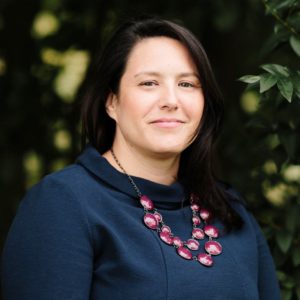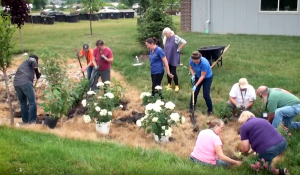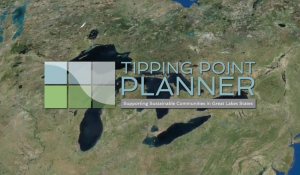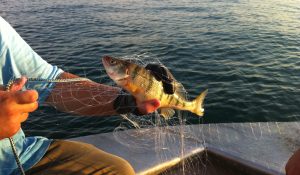May 12th, 2020 by IISG
One of the most common questions Illinois-Indiana Sea Grant (IISG) gets during the springtime is, “When will your buoys be out on the water?” When the weather begins warming up for the year, boaters, anglers and other users of Lake Michigan rely on buoy data to make decisions about when they will visit the lake and whether it is safe to boat, swim, kayak, or do other activities.

In Episode 11 of Teach Me About the Great Lakes, titled “An Empty Chunk of Fiberglass,” Illinois-Indiana Sea Grant’s Stuart Carlton and Hope Charters talk with Jay Beugly, aquatic ecology specialist with Purdue University’s Department of Forestry and Natural Resources and IISG, about buoy deployment and retrieval each year. He discusses the issues faced during the pandemic, and why university policies and state regulations have delayed deployment. Beugly also gives listeners insights into technical problems the buoys sometimes experience while out on the water.
Teach Me About the Great Lakes is a monthly podcast in which Carlton—a social scientist who grew up in the South near the Gulf of Mexico—asks people to explain the biology, ecology and natural history of the Great Lakes. A new episode will be released on the first Monday of each month. The latest episode is embedded below.
If this isn’t enough buoy content for you, check out our How Buoys Help page and Two Yellow Buoys on Twitter.
Love this episode and want to hear more in the future? Subscribe on Apple Podcasts or Spotify, or use the RSS feed in your favorite podcast player.
If you have questions you want answered about the Great Lakes, reach out to @TeachGreatLakes on Twitter or contact Stuart Carlton.
Illinois-Indiana Sea Grant is a part of University of Illinois Extension and Purdue Extension.
May 4th, 2020 by IISG
We all know
buoys are critical for water safety on the Great Lakes, but did you know data is collected from an entire network of technology for scientists to analyze regional trends, natural resource managers to improve their work and policy makers to make informed decisions?

In Episode 10 of Teach Me About the Great Lakes, titled “A Lot of Different Kinds of Data,” Illinois-Indiana Sea Grant’s Stuart Carlton and Hope Charters talk with Kelli Paige, chief executive officer of the Great Lakes Observing System (GLOS), about how GLOS works with Illinois-Indiana Sea Grant and other partners across the Great Lakes to collect and visualize important and useful data. We also discuss how data use has changed as technology has changed and about GLOS’ Smart Great Lakes Initiative.
Teach Me About the Great Lakes is a monthly podcast in which Carlton—a social scientist who grew up in the South near the Gulf of Mexico—asks people to explain the biology, ecology and natural history of the Great Lakes. A new episode will be released on the first Monday of each month. The latest episode is embedded below.
If this isn’t enough buoy content for you, check out our How Buoys Help page and Two Yellow Buoys on Twitter.
Love this episode and want to hear more in the future? Subscribe on Apple Podcasts or Spotify, or use the RSS feed in your favorite podcast player.
If you have questions you want answered about the Great Lakes, reach out to @TeachGreatLakes on Twitter or contact Stuart Carlton.
Illinois-Indiana Sea Grant is a part of University of Illinois Extension and Purdue Extension.
April 30th, 2020 by IISG
Interested in exploring the Great Lakes even though you’re stuck at home? With the global pandemic causing lockdowns and travel restrictions in many states, Illinois-Indiana Sea Grant (IISG) specialists are moving their usual in-person outreach events to the virtual world. Through live video streaming, IISG scientists will share their expertise on a multitude of topics. As a partner in Michigan Sea Grant’s H.O.M.E.S. at Home series (named after the five Great Lakes: Huron, Ontario, Michigan, Erie, and Superior), our webinars will be focused on learning more about Great Lakes topics, but many will be general enough that learners across the nation can discover fun facts about their natural environments.
If you miss the livestream lessons, no need to worry. Our H.O.M.E.S. at Home educational content will be archived on the IISG YouTube channel. For more educational resources, visit our Learning at Home page. Below are our upcoming, free webinars.
Rainscaping and Rain Gardens
Friday, May 1 – 9:30 a.m. ET / 8:30 a.m. CT

The webinar will introduce participants to rainscaping and will specifically focus on an overview of rain garden benefits, siting, sizing, design, installation and maintenance considerations. This program is a very short introduction to the information shared during the 2 day, 15 hour Rainscaping Education Program workshops.
Presenters: Kara Salazar and John Orick
Join Webinar Watch on Facebook Live
Community Planning with Tipping Point Planner
Tuesday, May 5 – 10:30 a.m. ET / 9:30 a.m. CT
 The webinar will introduce participants to the free, online decision support tool features available in Tipping Point Planner for all Great Lakes states. The tools are resources for regional, county and municipal land use planning that focus on identifying natural resource issues and prioritizing critical areas. Tool topics address nutrient loading from agricultural and urban landscapes, land use changes and stream health.
The webinar will introduce participants to the free, online decision support tool features available in Tipping Point Planner for all Great Lakes states. The tools are resources for regional, county and municipal land use planning that focus on identifying natural resource issues and prioritizing critical areas. Tool topics address nutrient loading from agricultural and urban landscapes, land use changes and stream health.
Presenters: Kara Salazar, Dan Walker, and Lydia Utley
Join Webinar Watch on Facebook Live
Hot and Cold: How do warm summers and icy winters affect fish?
Thursday, May 7 – 10:30 a.m. ET / 9:30 a.m. CT
 Do you live in a temperate climate with warm summers and cold winters? Have you noticed how lakes and ponds freeze over in the winter but get as warm as bath water in the summer? In this webinar, you’ll learn about the unique annual physical changes that happen to water in your local lakes and ponds. The physical properties of water allow aquatic organisms to survive long, cold winters under thick ice as well as hot summers with warm water temperatures. Temperature can create barriers within ponds and lakes that can be tough for its inhabitants to cross. These annual changes can influence the location of oxygen and food for fish and other aquatic organisms as well as impact our experiences when we swim at the beach.
Do you live in a temperate climate with warm summers and cold winters? Have you noticed how lakes and ponds freeze over in the winter but get as warm as bath water in the summer? In this webinar, you’ll learn about the unique annual physical changes that happen to water in your local lakes and ponds. The physical properties of water allow aquatic organisms to survive long, cold winters under thick ice as well as hot summers with warm water temperatures. Temperature can create barriers within ponds and lakes that can be tough for its inhabitants to cross. These annual changes can influence the location of oxygen and food for fish and other aquatic organisms as well as impact our experiences when we swim at the beach.
Presenter: Jay Beugly
Join Webinar Watch on Facebook Live
Illinois-Indiana Sea Grant is a part of University of Illinois Extension and Purdue Extension.
Writer: Hope Charters
April 29th, 2020 by IISG
Lake levels continue to be above average and reaching near-record highs across the Great Lakes basin, causing problems with coastal erosion, flooding, infrastructure damage and economic loss. In addition to increasing lake levels and more nutrient runoff from stronger storms, the region is also experiencing warming weather and therefore warmer waters. Research points to climate change as the cause. Gabriel Filippelli, professor and director of the Center for Urban Health in the Department of Earth Sciences at Indiana University–Purdue University Indianapolis, references the March 2020 Quarterly Climate Impacts and Outlook Report for the Great Lakes Region—produced by Illinois-Indiana Sea Grant, Midwestern Regional Climate Center and partners—in a climate change story as part of the Pulitzer Center’s nationwide Connected Coastlines reporting initiative. Read the full story: Climate change threatens drinking water quality across the Great Lakes. Excerpt below.
“Do Not Drink/Do Not Boil” is not what anyone wants to hear about their city’s tap water. But the combined effects of climate change and degraded water quality could make such warnings more frequent across the Great Lakes region.
A preview occurred on July 31, 2014, when a nasty green slime – properly known as a harmful algal bloom, or HAB – developed in the western basin of Lake Erie. Before long it had overwhelmed the Toledo Water Intake Crib, which provides drinking water to nearly 500,000 people in and around the city.
Tests revealed that the algae was producing microcystin, a sometimes deadly liver toxin and suspected carcinogen. Unlike some other toxins, microcystin can’t be rendered harmless by boiling. So the city issued a “Do Not Drink/Do Not Boil” order that set off a three-day crisis.
Local stores soon ran out of bottled water. Ohio’s governor declared a state of emergency, and the National Guard was called in to provide safe drinking water until the system could be flushed and treatment facilities brought back on line.
The culprit was a combination of high nutrient pollution – nitrogen and phosphorus, which stimulate the growth of algae – from sewage, agriculture and suburban runoff, and high water temperatures linked to climate change. This event showed that even in regions with resources as vast as the Great Lakes, water supplies are vulnerable to these kinds of man-made threats.
Illinois-Indiana Sea Grant is a part of University of Illinois Extension and Purdue Extension.
April 28th, 2020 by IISG
In a recent article, The Charles Stewart Mott Foundation highlighted the tie between the need for frequent hand washing during this worldwide pandemic and the existing problem of rising water rates in the Chicago area, referencing a study published by Illinois-Indiana Sea Grant, Chicago Metropolitan Planning Council and Elevate Energy. Read the full story: Amid COVID-19 pandemic, the need for frequent hand-washing collides with soaring water rates. Excerpt below.
At a time when hand-washing is critical to preventing the spread of COVID-19, a new study shows water affordability is a bigger problem than previously recognized in a region that borders Lake Michigan — the fifth largest lake on Earth.
Soaring water rates and stagnant income growth over the past decade have made tap water unaffordable for thousands of households in the Chicago metro area, according to a study by the Metropolitan Planning Council, Elevate Energy and Illinois-Indiana Sea Grant. The study focused on a seven-county region in northeastern Illinois, but researchers said the findings mirror national trends.
A near doubling of water rates in greater Chicago over the past decade has forced some residents to choose between paying the water bill or buying food. Some households in the most economically distressed areas must work 100 hours each month just to pay the water bill, according to the study.
“As water rates increase and incomes remain stagnant, many households are struggling to pay their water bill,” said Caroline Pakenham, water program manager at Elevate Energy. “This study is an important first step to highlight growing issues of water affordability in our region and encourage dialogue around potential solutions.”
Related: Water affordability report helps inform new Chicago water billing policy
Illinois-Indiana Sea Grant is a part of University of Illinois Extension and Purdue Extension.
Contact: Margaret Schneemann
April 21st, 2020 by IISG
As a follow-up to the previous two podcast episodes about the COVID-19 pandemic in which we focus on spending time outdoors, we get yet another perspective, this time from
Ming Kuo, director of the University of Illinois at Urbana-Champaign Landscape and Human Health Laboratory. How can this stressful time affect our psychological and physical well-being? What are some benefits of spending time engaging with the natural world?

(University of Illinois at Urbana-Champaign/L. Brian Stauffer)
In this episode of Teach Me About the Great Lakes, titled “The Hamster Wheel of Rumination,” Illinois-Indiana Sea Grant’s Stuart Carlton and Irene Miles talk with Kuo, a professor of natural resources and environmental sciences, who has studied how natural environments relate to healthy human functioning. She explains how finding ways to truly relax, or to be awestruck, can help support us through this time, and in general.
Teach Me About the Great Lakes is a monthly podcast in which Carlton—a social scientist who grew up in the South near the Gulf of Mexico—asks people to explain the biology, ecology and natural history of the Great Lakes. A new episode will be released on the first Monday of each month. The latest episode is embedded below.
Love this episode and want to hear more in the future? Subscribe on Apple Podcasts or Spotify, or use the RSS feed in your favorite podcast player.
If you have questions you want answered about the Great Lakes, reach out to @TeachGreatLakes on Twitter or email Stuart Carlton at jsc@purdue.edu.
Illinois-Indiana Sea Grant is a part of University of Illinois Extension and Purdue Extension.
April 17th, 2020 by IISG
Update 4/18: We’ve hit our 300-person limit for this free webinar series, so we have to shut down registration early. What a great response from everyone interested in stormwater management and green infrastructure! We’re excited to help you learn more about rainscaping.
The Purdue Rainscaping Education Team is offering a free webinar series called Introduction to Rainscaping and Rain Gardens. The four-part series, comprised of one-hour webinars, will take place on April 21, 23, 28 and 30. Registration is required.
“Since we cannot offer in-person spring workshops due to COVID-19, the Rainscaping Education Program’s short webinar series brings you a way to learn more about rainscaping and rain gardens in your own home,” said Kara Salazar, assistant program leader and extension specialist for sustainable communities. “We hope the series inspires attendees to establish rainscaping practices on their landscape. Additionally, we encourage participants to join us when we can offer the next round of in-person workshops to learn more in depth information and also take tours of existing raingardens and participate in the construction of a demonstration rain garden.”
The four-part series will cover topics ranging from an introduction to rainscaping and rain gardens, to site selection, plant selection and installation and maintenance.
Attendees must register two days before the start of the first webinar (April 19) and should plan on attending all four parts of the series. An email containing the access link will be sent to registrants prior to each session.
Webinar Series Schedule
Introduction to Rainscaping, Rain Gardens and the Purdue Rainscaping Education Program
Tuesday, April 21
Noon – 1 p.m. CT / 1 – 2 p.m. ET
Presenter: John Orick, Purdue Master Gardener State Coordinator
Introduction to Rain Garden Site Selection and Analysis
Thursday, April 23
Noon – 1 p.m. CT / 1 – 2 p.m. ET
Presenter: Curt Emanuel, Boone County Purdue Extension Educator, County Extension Director
Introduction to Rain Garden Plant Selection and Design
Tuesday, April 28
Noon – 1 p.m. CT / 1 – 2 p.m. ET
Presenter: Rosie Lerner, Purdue Extension Consumer Horticulture Specialist
Introduction to Installation and Maintenance
Thursday, April 30
Noon – 1 p.m. CT / 1 – 2 p.m. ET
Presenter: Laura Esman, Managing Director, Indiana Water Resources Research Center and Research Associate & Lab Manager, Natural Resources Social Science Lab
For questions, please contact Kara Salazar, Assistant Program Leader and Extension Specialist for Sustainable Communities, Purdue Extension and Illinois-Indiana Sea Grant at salazark@purdue.edu.
Resources
Rain Gardens Go with the Flow, Indiana Yard and Garden, Purdue Horticulture
Rainscaping Program
Master Gardeners Program
Rainscaping Education Program Highlighted in NOAA Annual Report, Got Nature? Post, Purdue Extension
What is Rainscaping? Purdue Rainscaping Education Program Video, Purdue Extension
Q&A About Drainage Water Recycling for the Midwest, The Education Store, Purdue Extension resource center
Become a Purdue Master Gardener, The Education Store
Climate Change: How will you manage stormwater runoff?, The Education Store
Plan Today For Tomorrow’s Flood, The Education Store
Illinois-Indiana Sea Grant is a part of University of Illinois Extension and Purdue University Extension.
Contact: Kara Salazar, Assistant Program Leader and Extension Specialist for Sustainable Communities, Illinois-Indiana Sea Grant and Purdue University Department of Forestry and Natural Resources
April 13th, 2020 by IISG
Microbes are everywhere on our planet. As the current health crisis has shown, they have the ability to bring everything to a screeching halt. But are they all bad?

(University of Illinois at Chicago)
In this episode of Teach Me About the Great Lakes, titled “The Really Delicious Carbon,” Illinois-Indiana Sea Grant’s Stuart Carlton and Carolyn Foley talk with Dr. Rachel Poretsky, an assistant professor in biological sciences at the University of Illinois at Chicago. She studies microbial ecology and biogeochemistry, bacterial diversity, and community structure and interactions in natural environments. These studies include microbial research completed with funding from Illinois-Indiana Sea Grant and Michigan Sea Grant. In the podcast, Poretsky explains the role microbes play in aquatic systems—including the Lake Michigan food web—and their incredible ability to adapt to changes in their surroundings.
Microbes are found everywhere, “from the atmosphere to below the sea floor,” said Poretsky. “These are the organisms that I think of as the base of the food web, and they’re really important in all sorts of aquatic environments. They turn the carbon that comes from carbon dioxide in the atmosphere into carbon that’s usable for other [organisms].”
Teach Me About the Great Lakes is a monthly podcast in which Carlton—a social scientist who grew up in the South near the Gulf of Mexico—asks people to explain the biology, ecology and natural history of the Great Lakes. A new episode will be released on the first Monday of each month. The latest episode is embedded below.
Love this episode and want to hear more in the future? Subscribe on Apple Podcasts or Spotify, or use the RSS feed in your favorite podcast player.
If you have questions you want answered about the Great Lakes, reach out to @TeachGreatLakes on Twitter or email Stuart Carlton at jsc@purdue.edu.
Illinois-Indiana Sea Grant is a part of University of Illinois Extension and Purdue Extension.
March 31st, 2020 by IISG
As a follow-up to the last podcast episode about the COVID-19 pandemic in which we talked to an epidemiologist, we get another perspective on COVID-19 and outdoor recreation, this time from E.R. resident Dr. Frank Zadravecz. What’s it like to be in the emergency department of a hospital during this time? How are hospitals handling general emergencies and an influx of COVID-19 patients all at once? What everyday risks should we be considering to keep ourselves out of the hospital and avoid overburdening the healthcare system?
In this episode of Teach Me About the Great Lakes, titled “A Lot of This Is in Our Own Hands,” Illinois-Indiana Sea Grant’s Stuart Carlton and Hope Charters talk with Frank Zadravecz, a former epidemiologist who is now an emergency medicine resident at University of Utah School of Medicine. Zadravecz explains the benefits of social distancing during the early phase of a pandemic, how viewing yourself as the exception can create a snowball effect and what type of risks you take when choosing outdoor activities.
“If you think about the time of the year that we’re in, you know, where places in the Northern Hemisphere are starting to get warmer, we would naturally see an increase in outdoor activity for most populations or groups of people at this point,” said Zadravecz. “Interestingly, in the emergency department, we see a lot of this seasonality. Right about now and into the summer, we’ll start to see more injuries related to outdoor activity, more broken bones, more motor vehicle accidents here in Utah, we start seeing a lot of ATV accidents, mountain bike accidents, climbing accidents, etc. And so when you think about where you are getting your outdoor experience at the moment, it’s really important to think about those additional risks. Those additional risks are potentially overburdening emergency departments [during this critical time].”
If you are looking for information about coronavirus and COVID-19, we encourage you to turn to reputable sources such as your state’s health department.
Teach Me About the Great Lakes is a monthly podcast in which Carlton—a social scientist who grew up in the South near the Gulf of Mexico—asks people to explain the biology, ecology and natural history of the Great Lakes. A new episode will be released on the first Monday of each month. The latest episode is embedded below.
Love this episode and want to hear more in the future? Subscribe on Apple Podcasts or Spotify, or use the RSS feed in your favorite podcast player.
If you have questions you want answered about the Great Lakes, reach out to @TeachGreatLakes on Twitter or contact Stuart Carlton.
Illinois-Indiana Sea Grant is a part of University of Illinois Extension and Purdue Extension.




 The webinar will introduce participants to the free, online decision support tool features available in
The webinar will introduce participants to the free, online decision support tool features available in  Do you live in a temperate climate with warm summers and cold winters? Have you noticed how lakes and ponds freeze over in the winter but get as warm as bath water in the summer? In this webinar, you’ll learn about the unique annual physical changes that happen to water in your local lakes and ponds. The physical properties of water allow aquatic organisms to survive long, cold winters under thick ice as well as hot summers with warm water temperatures. Temperature can create barriers within ponds and lakes that can be tough for its inhabitants to cross. These annual changes can influence the location of oxygen and food for fish and other aquatic organisms as well as impact our experiences when we swim at the beach.
Do you live in a temperate climate with warm summers and cold winters? Have you noticed how lakes and ponds freeze over in the winter but get as warm as bath water in the summer? In this webinar, you’ll learn about the unique annual physical changes that happen to water in your local lakes and ponds. The physical properties of water allow aquatic organisms to survive long, cold winters under thick ice as well as hot summers with warm water temperatures. Temperature can create barriers within ponds and lakes that can be tough for its inhabitants to cross. These annual changes can influence the location of oxygen and food for fish and other aquatic organisms as well as impact our experiences when we swim at the beach.

